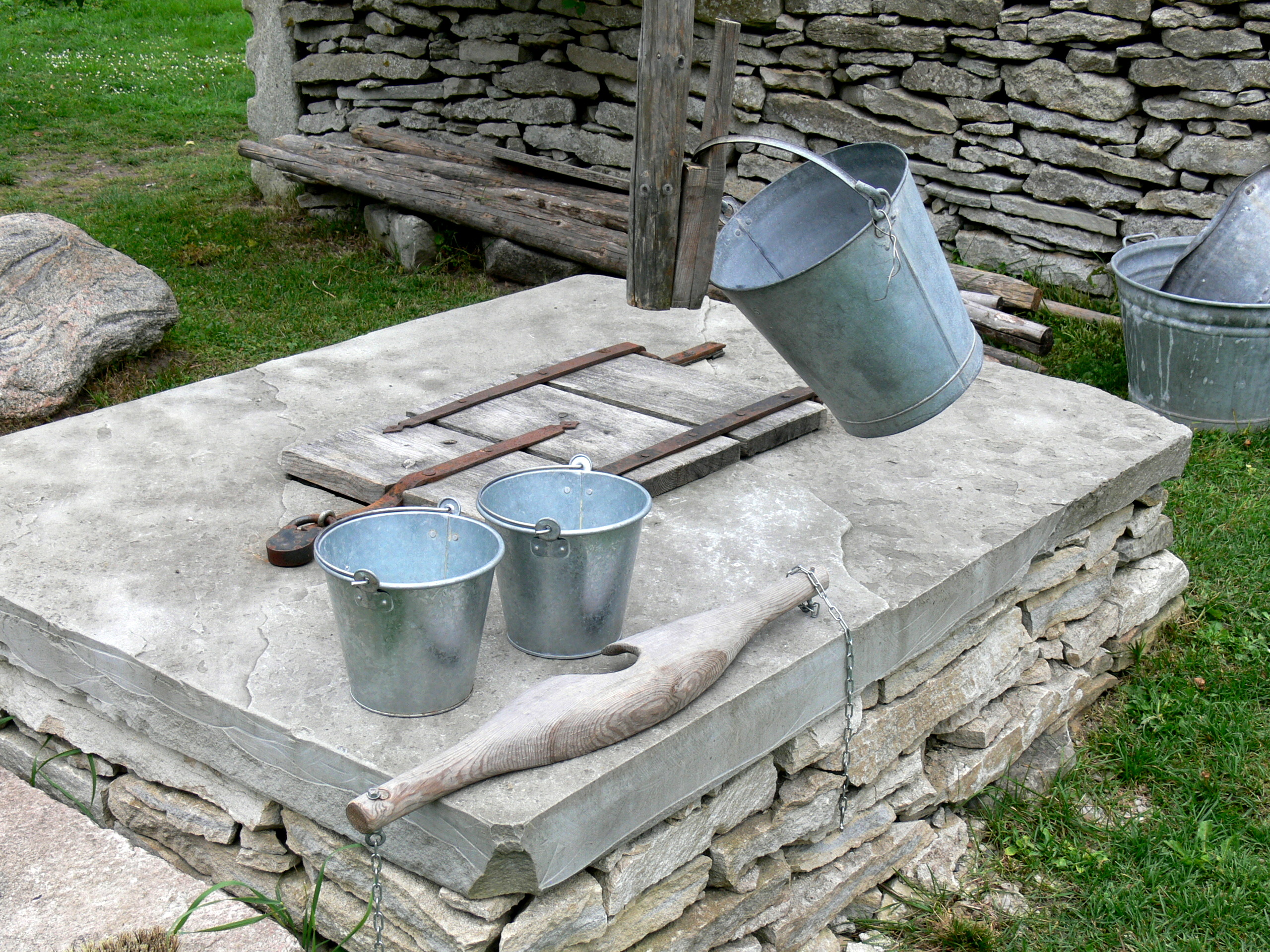|
Water Well Pump
A water well pump is a pump that is used in extracting water from a water well. Deep well pumps extract groundwater from subterranean aquifers, offering a reliable source of water independent of municipal networks. These pumps, often submersible and powered by electricity, can access water reserves located much deeper than shallow wells, ensuring a consistent supply even during periods of drought. They include different kinds of pumps, most of them submersible pumps: *Hand pump, manually operated *Injector, a jet-driven pump *Mechanical or rotary lobe pump requiring mechanical parts to pump water *Solar-powered water pump *Pump driven by air as used by the Amish *Pump driven by air as used in the Australian outback *Manual pumpless or hand pump wells requiring a human operator The pump replaces the use of a bucket A bucket is typically a watertight, vertical Cylinder (geometry), cylinder or Truncation (geometry), truncated Cone (geometry), cone or square, with an open top ... [...More Info...] [...Related Items...] OR: [Wikipedia] [Google] [Baidu] |
Pump
A pump is a device that moves fluids (liquids or gases), or sometimes Slurry, slurries, by mechanical action, typically converted from electrical energy into hydraulic or pneumatic energy. Mechanical pumps serve in a wide range of applications such as Water well pump, pumping water from wells, aquarium filtering, pond filtering and Water aeration, aeration, in the car industry for Water cooling, water-cooling and fuel injection, in the energy industry for Pumping (oil well), pumping oil and natural gas or for operating cooling towers and other components of heating, ventilation and air conditioning systems. In the medical industry, pumps are used for biochemical processes in developing and manufacturing medicine, and as artificial replacements for body parts, in particular the artificial heart and Penile implant, penile prosthesis. When a pump contains two or more pump mechanisms with fluid being directed to flow through them in series, it is called a ''multi-stage pump''. T ... [...More Info...] [...Related Items...] OR: [Wikipedia] [Google] [Baidu] |
Water
Water is an inorganic compound with the chemical formula . It is a transparent, tasteless, odorless, and Color of water, nearly colorless chemical substance. It is the main constituent of Earth's hydrosphere and the fluids of all known living organisms (in which it acts as a solvent). It is vital for all known forms of life, despite not providing food energy or organic micronutrients. Its chemical formula, , indicates that each of its molecules contains one oxygen and two hydrogen atoms, connected by covalent bonds. The hydrogen atoms are attached to the oxygen atom at an angle of 104.45°. In liquid form, is also called "water" at standard temperature and pressure. Because Earth's environment is relatively close to water's triple point, water exists on Earth as a solid, a liquid, and a gas. It forms precipitation in the form of rain and aerosols in the form of fog. Clouds consist of suspended droplets of water and ice, its solid state. When finely divided, crystalline ice ... [...More Info...] [...Related Items...] OR: [Wikipedia] [Google] [Baidu] |
Water Well
A well is an excavation or structure created on the earth by digging, driving, or drilling to access liquid resources, usually water. The oldest and most common kind of well is a water well, to access groundwater in underground aquifers. The well water is drawn up by a pump, or using containers, such as buckets that are raised mechanically or by hand. Water can also be injected back into the aquifer through the well. Wells were first constructed at least eight thousand years ago and historically vary in construction from a sediment of a dry watercourse to the qanats of Iran, and the stepwells and sakiehs of India. Placing a lining in the well shaft helps create stability, and linings of wood or wickerwork date back at least as far as the Iron Age. Wells have traditionally been sunk by hand digging, as is still the case in rural areas of the developing world. These wells are inexpensive and low-tech as they use mostly manual labour, and the structure can be lined with b ... [...More Info...] [...Related Items...] OR: [Wikipedia] [Google] [Baidu] |
Submersible Pump
A submersible pump (or electric submersible pump (ESP) is a device which has a hermetically sealed motor close-coupled to the pump body. The whole assembly is submerged in the fluid to be pumped. The main advantage of this type of pump is that it prevents pump cavitation, a problem associated with a high elevation difference between the pump and the fluid surface. Submersible pumps push fluid to the surface, rather than jet pumps, which create a vacuum and rely upon atmospheric pressure. Submersibles use pressurized fluid from the surface to drive a hydraulic motor downhole, rather than an electric motor, and are used in heavy oil applications with heated water as the motive fluid. History In. 1928 Armenian oil delivery system engineer and inventor Armais Arutunoff successfully installed the first submersible oil pump in an oil field. In 1929, Pleuger Pumps (today Pleuger Industries) developed the design of the submersible turbine pump, the forerunner of the modern multi-sta ... [...More Info...] [...Related Items...] OR: [Wikipedia] [Google] [Baidu] |
Hand Pump
Hand pumps are manually operated pumps; they use human power and mechanical advantage to move fluids or air from one place to another. They are widely used in every country in the world for a variety of industrial, marine, irrigation and leisure activities. There are many different types of hand pump available, mainly operating on a piston, diaphragm or rotary vane principle with a check valve on the entry and exit ports to the chamber operating in opposing directions. Most hand pumps are either piston pumps or plunger pumps, and are positive displacement. Hand pumps are commonly used in developing countries for both community supply and self-supply of water and can be installed on boreholes or hand-dug wells. History One sort of pump once common worldwide was a hand-powered water pump, or 'pitcher pump'. It was commonly installed over community water wells in the days before piped water supplies. In parts of Britain and Ireland, it was often called ''the parish ... [...More Info...] [...Related Items...] OR: [Wikipedia] [Google] [Baidu] |
Injector
An injector is a system of ducting and nozzles used to direct the flow of a high-pressure fluid in such a way that a lower pressure fluid is Entrainment (hydrodynamics), entrained in the jet and carried through a duct to a region of higher pressure. It is a fluid-dynamic pump with no moving parts except a valve to control inlet flow. Depending on the application, an injector can also take the form of an ''eductor-jet pump'', a ''water eductor'' or an ''aspirator''. An ''Vacuum ejector, ejector'' operates on similar principles to create a vacuum feed connection for braking systems etc. The motive fluid may be a liquid, steam or any other gas. The entrained suction fluid may be a gas, a liquid, a slurry, or a dust-laden gas stream. Steam injector The steam injector is a common device used for delivering water to steam boilers, especially in steam locomotives. It is a typical application of the injector principle used to deliver cold boiler feedwater, water to a boiler against ... [...More Info...] [...Related Items...] OR: [Wikipedia] [Google] [Baidu] |
Mechanics
Mechanics () is the area of physics concerned with the relationships between force, matter, and motion among Physical object, physical objects. Forces applied to objects may result in Displacement (vector), displacements, which are changes of an object's position relative to its environment. Theoretical expositions of this branch of physics has its origins in Ancient Greece, for instance, in the writings of Aristotle and Archimedes (see History of classical mechanics and Timeline of classical mechanics). During the early modern period, scientists such as Galileo Galilei, Johannes Kepler, Christiaan Huygens, and Isaac Newton laid the foundation for what is now known as classical mechanics. As a branch of classical physics, mechanics deals with bodies that are either at rest or are moving with velocities significantly less than the speed of light. It can also be defined as the physical science that deals with the motion of and forces on bodies not in the quantum realm. History ... [...More Info...] [...Related Items...] OR: [Wikipedia] [Google] [Baidu] |
Lobe Pump
A lobe pump, or rotary lobe pump, is a type of positive displacement pump. It is similar to a gear pump except the lobes are designed to almost meet, rather than touch and turn each other. An early example of a lobe pump is the Roots Blower, patented in 1860 to blow combustion air to melt iron in blast furnaces, but now more commonly used as an engine supercharger. Lobe pumps are used in a variety of industries including pulp and paper, chemical, food, beverage, pharmaceutical, and biotechnology. They are popular in these diverse industries because they offer superb sanitary qualities, high efficiency, reliability, corrosion resistance and good clean-in-place and sterilization-in-place (CIP/SIP) characteristics. Rotary pumps can handle solids (e.g., cherries and olives), slurries, pastes, and a variety of liquids. If wetted, they offer self-priming performance. A gentle pumping action minimizes product degradation. They also offer continuous and intermittent reversible flows ... [...More Info...] [...Related Items...] OR: [Wikipedia] [Google] [Baidu] |
Solar Energy
Solar energy is the radiant energy from the Sun's sunlight, light and heat, which can be harnessed using a range of technologies such as solar electricity, solar thermal energy (including solar water heating) and solar architecture. It is an essential source of renewable energy, and its technologies are broadly characterized as either passive solar or active solar depending on how they capture and distribute solar energy or convert it into solar power. Active solar techniques include the use of photovoltaic systems, concentrated solar power, and solar water heating to harness the energy. Passive solar techniques include designing a building for better daylighting (architecture), daylighting, selecting materials with favorable thermal mass or light-dispersing properties, and organizing spaces that ventilation (architecture), naturally circulate air. In 2011, the International Energy Agency said that "the development of affordable, inexhaustible and clean solar energy technolo ... [...More Info...] [...Related Items...] OR: [Wikipedia] [Google] [Baidu] |
Amish
The Amish (, also or ; ; ), formally the Old Order Amish, are a group of traditionalist Anabaptism, Anabaptist Christianity, Christian Christian denomination, church fellowships with Swiss people, Swiss and Alsace, Alsatian origins. As they maintain Nonconformity to the world#Anabaptism, a degree of separation from surrounding populations, and hold their faith in common, the Amish have been described by certain scholars as an ethnoreligious group, combining features of an ethnicity and a Christian denomination. The Amish are closely related to Old Order Mennonites and Conservative Mennonites, denominations that are also a part of Anabaptist Christianity. The Amish are known for simple living, plain dress, Christian pacifism#Anabaptist churches, Christian pacifism, and slowness to adopt many conveniences of modern technology, with a view neither to interrupt family time, nor replace face-to-face conversations whenever possible, and a view to maintain self-sufficiency. The Amis ... [...More Info...] [...Related Items...] OR: [Wikipedia] [Google] [Baidu] |
Bucket
A bucket is typically a watertight, vertical Cylinder (geometry), cylinder or Truncation (geometry), truncated Cone (geometry), cone or square, with an open top and a flat bottom that is attached to a semicircular carrying handle (grip), handle called the ''Bail handle, bail''. A bucket is usually an open-top container. In contrast, a Pail (container), pail can have a top or lid and is a shipping container. In non-technical usage, the two terms are often used interchangeably. Types and uses A number of bucket types exist, used for a variety of purposes. Though most of these are functional purposes, a number, including those constructed from precious metals, are used for ceremonial purposes. Common types of bucket and their adjoining purposes include: * Water buckets used to carry water * Household and garden buckets used for carrying liquids and granular products * Elaborate ceremonial or ritual buckets constructed of bronze, ivory or other materials, found in several ancient ... [...More Info...] [...Related Items...] OR: [Wikipedia] [Google] [Baidu] |
Pumps
A pump is a device that moves fluids (liquids or gases), or sometimes slurries, by mechanical action, typically converted from electrical energy into hydraulic or pneumatic energy. Mechanical pumps serve in a wide range of applications such as pumping water from wells, aquarium filtering, pond filtering and aeration, in the car industry for water-cooling and fuel injection, in the energy industry for pumping oil and natural gas or for operating cooling towers and other components of heating, ventilation and air conditioning systems. In the medical industry, pumps are used for biochemical processes in developing and manufacturing medicine, and as artificial replacements for body parts, in particular the artificial heart and penile prosthesis. When a pump contains two or more pump mechanisms with fluid being directed to flow through them in series, it is called a ''multi-stage pump''. Terms such as ''two-stage'' or ''double-stage'' may be used to specifically describ ... [...More Info...] [...Related Items...] OR: [Wikipedia] [Google] [Baidu] |







